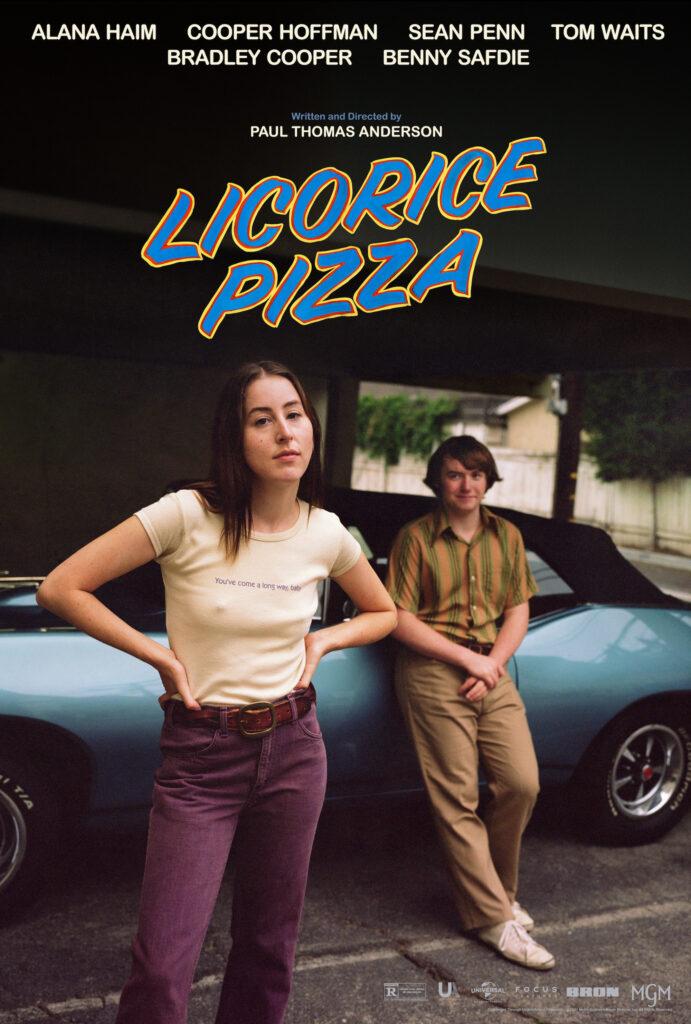★★★★☆
Four years after the release of his last cinematic opus, acclaimed filmmaker Paul Thomas Anderson has returned with “Licorice Pizza,” a movie that proves as bizarre as its title.
Anderson rekindles his cinematic love affair with California’s San Fernando Valley, which he previously explored in “Magnolia” and “Boogie Nights,” in this 133-minute joyride. “Licorice Pizza” follows the precarious romance between Alana Kane (Alana Haim), a 25-year-old woman who works for a high school yearbook photography company and Gary Valentine (Cooper Hoffman), an endearing 15-year-old who attained minor fame as a child actor in 1970s Hollywood. As the film sprawls and deepens, the events onscreen become increasingly strange — and simultaneously captivating.
Despite their problematic age gap, Gary falls for Alana, and the film chronicles all of the familiar trials of first love. Meanwhile, the lovers’ 1970s milieu rages around them and their adventures lead them to colorful characters who dance in and out of their lives.
The acting was the most enjoyable aspect of the film, as the cast’s characterizations made the plot come to life. Anderson took a significant risk by casting two young actors with minimal experience as his leads, but his gamble was a success. Alana Haim, vocalist of the eponymous band, Haim, delivers a lived-in, poignantly vulnerable performance as Alana Kane. Haim portrays a conflicted young woman struggling to discover her calling in a volatile era, producing one of the finest performances of the year.
Haim’s subtle characterization of Alana as being outwardly confident, yet inwardly unsure of herself is juxtaposed with the virulent charisma of her co-star, Cooper Hoffman, who lights up the screen as the amicable Gary Valentine. The son of the late actor Philip Seymour Hoffman, who was a frequent Anderson collaborator, Cooper Hoffman is effortless in his role, using charming grins and grandiose gestures to evince the confidence and theatricality one would only expect of a child actor.
A handful of memorable side characters also complement the outstanding work of the film’s young stars. Sean Penn’s and Tom Waits’s flamboyant turns as over-the-hill Hollywood stars Jack Holden and Rex Blau, respectively, furnish the outlandish personas necessary to contextualize some of the movie’s strangest and most memorable scenes.
Perhaps the most unforgettable supporting performance is that of Georgetown’s own Bradley Cooper (COL ’97), who plays Jon Peters, an eccentric real-life film producer who dated Barbara Streisand in the 1970s. Cooper brings Peters’s erratic character to life, generating some of the movie’s funniest moments while offering a sobering depiction of one of the idiosyncratic individuals who built 1970s Hollywood.
Excessive commentary, however, becomes the film’s most indelible quality and only major flaw. By shoving a host of increasingly risible characters onscreen, the movie attempts to comment on many 1970s events and conditions, from eccentricity in Hollywood to intolerance in politics to the short attention span of a capitalist society.
In its efforts to represent the disparate aspects of life in 1970s California, the film falls short, and Anderson’s haphazard coverage of such a broad range of topics ultimately leads to a jumbled mess that fails to give each facet of the movie’s intriguing setting its due.
However, this messy construction is salvaged by the captivating, unorthodox love story that unfolds between Alana and Gary — an unlikely match. Their paths, though fraught with challenges and twists that threaten to tear them apart, inevitably lead into each other’s arms.
Unexpectedly, it is Alana who comes of age in “Licorice Pizza,” while Gary, though much younger, has in many ways already done so. As Alana is pulled in different directions by the characters around her, she must navigate the turbulent world of Hollywood and learn to follow her heart. The unconventional design of this romance is what ultimately makes the film so special.
In the film, Anderson successfully highlights the magnetic nature of love and how attraction can span distances and time periods to draw very different people together, even if it means breaking social convention. In terms of Alana and Gary’s age gap, Anderson leaves most of this aspect of the relationship up to interpretation, neglecting to provide explicit commentary on the nature of such a romance.
Anderson also manages to transcend coming-of-age tropes by subverting audience expectations. With the help of his talented young leads’ nuanced performances, Anderson artfully displays an uncommonly self-assured teenager with worldly experience well beyond his years and a young woman on the cusp of adulthood who has yet to find her way. This reversal of dispositions relative to the characters’ ages makes Alana seem younger than she really is and Gary, conversely, seem older than he is, so their relationship feels unexpectedly plausible.
“Licorice Pizza” is another vibrant, complex creation from Paul Thomas Anderson. Though its messy execution may confuse some viewers, those that ruminate on the plot and follow each character on-screen will find themselves immersed in a unique world and wiser about the otherwise elusive nature of young love.














